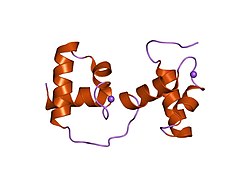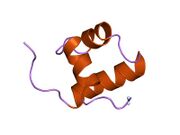Biology:MYB (gene)
| Myb-like DNA-binding domain | |||||||||
|---|---|---|---|---|---|---|---|---|---|
| Identifiers | |||||||||
| Symbol | Myb_DNA-binding | ||||||||
| Pfam | PF00249 | ||||||||
| InterPro | IPR001005 | ||||||||
| PROSITE | PDOC00037 | ||||||||
| CATH | 1irz | ||||||||
| SCOP2 | 1irz / SCOPe / SUPFAM | ||||||||
| CDD | cd00167 | ||||||||
| |||||||||
 Generic protein structure example |
Myb genes are part of a large gene family of transcription factors found in animals and plants. In humans, it includes Myb proto-oncogene like 1 and Myb-related protein B in addition to MYB proper.[1][2] Members of the extended SANT/Myb family also include the SANT domain and other similar all-helical homeobox-like domains.
Function
Viral
The Myb gene family is named after the eponymous gene in Avian myeloblastosis virus. The viral Myb (v-Myb, P01104) recognizes the sequence 5'-YAACKG-3'. It causes myeloblastosis (myeloid leukemia) in chickens.[3] Compared to the normal animal cellular Myb (c-myb), v-myb contains deletions in the C-terminal regulatory domain, leading to aberrant activation of other oncogenes.[4]
Animals
Myb proto-oncogene protein is a member of the MYB (myeloblastosis) family of transcription factors. The protein contains three domains, an N-terminal DNA-binding domain, a central transcriptional activation domain and a C-terminal domain involved in transcriptional repression. It may play a role in cell cycle regulation. Like the viral version, this gene is an oncogene, and rearrangements of the gene (often involving deletion in the C-terminal domain) causes cancer.[4]
Plants
MYB factors represent a family of proteins that include the conserved MYB DNA-binding domain. Plants contain a MYB-protein subfamily that is characterised by the R2R3-type MYB domain.[5]
In maize, phlobaphenes are synthesized in the flavonoids synthetic pathway[6] from polymerisation of flavan-4-ols[7][8] which encodes an R2R3 myb-like transcriptional activator[9] of the A1 gene encoding for the dihydroflavonol 4-reductase (reducing dihydroflavonols into flavan-4-ols)[10] while another gene (Suppressor of Pericarp Pigmentation 1 or SPP1) acts as a suppressor.[11] The maize P gene encodes a Myb homolog that recognizes the sequence CCWACC, in sharp contrast with the YAACGG bound by vertebrate Myb proteins.[12]
In sorghum, the corresponding yellow seed 1 gene (y1)[13] also encodes a R2R3 type of Myb domain protein that regulates the expression of chalcone synthase, chalcone isomerase and dihydroflavonol reductase genes required for the biosynthesis of 3-deoxyflavonoids.[14]
Ruby is a MYB transcriptional activator of genes that produce anthocyanin in citrus fruits. In most citrus varieties Ruby is non-functional, but in blood oranges it upregulates anthocyanin production to produce the characteristic red color of the fruit.[15]
See also
References
- ↑ "The c-Myb functions as a downstream target of PDGF-mediated survival signal in vascular smooth muscle cells". Biochem Biophys Res Commun 360 (2): 433–6. Jul 2007. doi:10.1016/j.bbrc.2007.06.078. PMID 17599807.
- ↑ "Entrez Gene: v-myb myeloblastosis viral oncogene homolog (avian)". https://www.ncbi.nlm.nih.gov/sites/entrez?Db=gene&Cmd=ShowDetailView&TermToSearch=4602.
- ↑ "Subcellular localization of proteins encoded by oncogenes of avian myeloblastosis virus and avian leukemia virus E26 and by chicken c-myb gene". Cell 37 (2): 537–47. June 1984. doi:10.1016/0092-8674(84)90384-2. PMID 6327074.
- ↑ 4.0 4.1 "Situational awareness: regulation of the myb transcription factor in differentiation, the cell cycle and oncogenesis". Cancers 6 (4): 2049–71. October 2014. doi:10.3390/cancers6042049. PMID 25279451.
- ↑ "The R2R3-MYB gene family in Arabidopsis thaliana". Curr. Opin. Plant Biol. 4 (5): 447–56. October 2001. doi:10.1016/s1369-5266(00)00199-0. PMID 11597504.
- ↑ "Effect of grain colour gene (R) on grain dormancy and sensitivity of the embryo to abscisic acid (ABA) in wheat". J. Exp. Bot. 53 (374): 1569–74. July 2002. doi:10.1093/jxb/erf005. PMID 12096095.
- ↑ Winkel-Shirley B (June 2001). "Flavonoid biosynthesis. A colorful model for genetics, biochemistry, cell biology, and biotechnology". Plant Physiol. 126 (2): 485–93. doi:10.1104/pp.126.2.485. PMID 11402179.
- ↑ "The maize unstable factor for orange1 is a dominant epigenetic modifier of a tissue specifically silent allele of pericarp color1". Genetics 163 (3): 1135–46. March 2003. doi:10.1093/genetics/163.3.1135. PMID 12663550.
- ↑ Structural And Transcriptional Analysis Of The Complex P1-wr Cluster In Maize. Wolfgang Goettel, Joachim Messing. Plant & Animal Genomes XVI Conference
- ↑ "Functional conservation of plant secondary metabolic enzymes revealed by complementation of Arabidopsis flavonoid mutants with maize genes". Plant Physiol. 127 (1): 46–57. September 2001. doi:10.1104/pp.127.1.46. PMID 11553733. PMC 117961. http://www.plantphysiol.org/cgi/reprint/127/1/46.pdf.
- ↑ "Suppressor of Pericarp Pigmentation 1 (SPP1), a novel gene involved in phlobaphene accumulation in maize (Zea mays L.) pericarps.". Maydica 47 (1): 51–58. 2002. INIST:13772300
- ↑ "The myb-homologous P gene controls phlobaphene pigmentation in maize floral organs by directly activating a flavonoid biosynthetic gene subset". Cell 76 (3): 543–554. 1994. doi:10.1016/0092-8674(94)90117-1. PMID 8313474.
- ↑ "Characterization of a deletion allele of a sorghum Myb gene yellow seedl showing loss of 3-deoxyflavonoids". Plant Science 169 (3): 542–552. 2005. doi:10.1016/j.plantsci.2005.05.007. INIST:16983977
- ↑ "Comparative structural and functional characterization of sorghum and maize duplications containing orthologous myb transcription regulators of 3-deoxyflavonoid biosynthesis". Plant Mol. Biol. 60 (2): 185–99. January 2006. doi:10.1007/s11103-005-3568-1. PMID 16429259.
- ↑ "Retrotransposons control fruit-specific, cold-dependent accumulation of anthocyanins in blood oranges". Plant Cell 24 (3): 1242–55. 2012. doi:10.1105/tpc.111.095232. PMID 22427337.
Further reading
- "The myb gene family in cell growth, differentiation and apoptosis.". Oncogene 18 (19): 3017–33. 1999. doi:10.1038/sj.onc.1202839. PMID 10378697.
- "Positive autoregulation of c-myb expression via Myb binding sites in the 5' flanking region of the human c-myb gene.". Mol. Cell. Biol. 11 (12): 6166–76. 1991. doi:10.1128/mcb.11.12.6166-6176.1991. PMID 1944282.
- "Transcriptional activation by human c-myb and v-myb genes.". Oncogene 5 (5): 657–61. 1990. PMID 2189102.
- "Alternative splicing of the human c-myb gene.". Oncogene 5 (8): 1117–24. 1990. PMID 2202948.
- "Identification of alternatively spliced transcripts for human c-myb: molecular cloning and sequence analysis of human c-myb exon 9A sequences.". Oncogene 4 (12): 1419–23. 1990. PMID 2687764.
- "Sublocalization of c-myb to 6q21----q23 by in situ hybridization and c-myb expression in a human teratocarcinoma with 6q rearrangements.". Cytogenet. Cell Genet. 41 (3): 129–35. 1986. doi:10.1159/000132217. PMID 3007038.
- "Studies of the human c-myb gene and its product in human acute leukemias.". Science 233 (4761): 347–51. 1986. doi:10.1126/science.3014652. PMID 3014652. Bibcode: 1986Sci...233..347S.
- "Human c-myb protooncogene: nucleotide sequence of cDNA and organization of the genomic locus.". Proc. Natl. Acad. Sci. U.S.A. 83 (24): 9636–40. 1987. doi:10.1073/pnas.83.24.9636. PMID 3540945.
- "Regulation of proliferation and cytokine expression of bone marrow fibroblasts: role of c-myb.". J. Exp. Med. 178 (3): 997–1005. 1993. doi:10.1084/jem.178.3.997. PMID 7688794.
- "High affinity DNA binding of native full length c-Myb and differential proteolytic sensitivity of its N- and C-terminal domains.". Oncogene 10 (11): 2221–8. 1995. PMID 7784067.
- "Identification of a second promoter in the human c-myb proto-oncogene.". Oncogene 9 (1): 227–35. 1994. PMID 8302584.
- "Detection of proteins that bind to the leucine zipper motif of c-Myb.". Oncogene 9 (1): 305–11. 1994. PMID 8302594.
- "Stress-associated modulation of proto-oncogene expression in human peripheral blood leukocytes.". Behav. Neurosci. 107 (3): 525–9. 1993. doi:10.1037/0735-7044.107.3.525. PMID 8329139.
- "The EVES motif mediates both intermolecular and intramolecular regulation of c-Myb.". Genes Dev. 10 (15): 1858–69. 1996. doi:10.1101/gad.10.15.1858. PMID 8756344.
- "Functional analysis of phosphorylation at serine 532 of human c-Myb by MAP kinase.". Biol. Chem. 377 (11): 721–30. 1997. doi:10.1515/bchm3.1996.377.11.721. PMID 8960373.
- "Molecular cloning reveals that the p160 Myb-binding protein is a novel, predominantly nucleolar protein which may play a role in transactivation by Myb.". Mol. Cell. Biol. 18 (2): 989–1002. 1998. doi:10.1128/MCB.18.2.989. PMID 9447996.
- "c-Maf interacts with c-Myb to regulate transcription of an early myeloid gene during differentiation.". Mol. Cell. Biol. 18 (5): 2729–37. 1998. doi:10.1128/mcb.18.5.2729. PMID 9566892.
- "Pim-1 kinase and p100 cooperate to enhance c-Myb activity.". Mol. Cell 2 (4): 417–25. 1998. doi:10.1016/S1097-2765(00)80141-0. PMID 9809063.
- "c-Myb down-regulation is associated with human colon cell differentiation, apoptosis, and decreased Bcl-2 expression.". Cancer Res. 58 (22): 5168–75. 1998. PMID 9823328.
- "C/EBPepsilon directly interacts with the DNA binding domain of c-myb and cooperatively activates transcription of myeloid promoters.". Blood 93 (10): 3327–37. 1999. doi:10.1182/blood.V93.10.3327. PMID 10233885.
External links
- MYB+protein,+human at the US National Library of Medicine Medical Subject Headings (MeSH)
- Drosophila Myb oncogene-like - The Interactive Fly
- Arabidospsis thaliana MYB family at Database of Arabidopsis Transcription Factors (DATF)
This article incorporates text from the United States National Library of Medicine, which is in the public domain.
 |

















